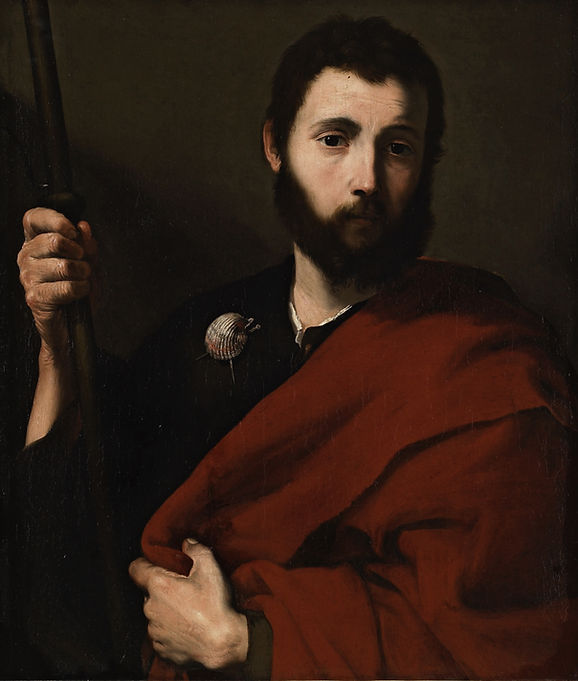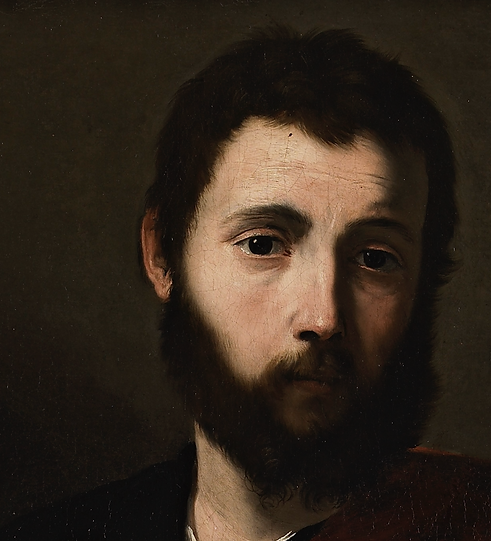FG FINE ART LTD

Jusepe de Ribera, called lo Spagnoletto
Játiva, 1591 - Naples, 1652
Generally described as a master of ‘earthly’ realism, Ribera drew his inspiration equally from daily life and the art of Caravaggio. His naturalism was inspired by the Lombard master, as he understood how the latter had brilliantly adapted classical stylistic canons to non-classical types. He identified the classical foundation inherent in Italian art and adopted its tradition.

Saint James the Greater, c. 1630–35
Oil on canvas, 74 x 64 cm
Provenance
Switzerland, private collection
London, Helikon Gallery, by 1974
Paris, Galerie Canesso, by 2008
Private collection
Bibliography
N. Spinosa, L’Opera completa del Ribera, Milan 1978, pp. 100-101
A.E. Pérez Sánchez, in Ribera 1591-1652, exhibition catalogue, Madrid 1992, p. 254
N. Spinosa, Ribera, Naples 2003, p. 278
N. Spinosa, Ribera, Naples 2006, p. 302
N. Spinosa, Ribera, La Obra Completa, Madrid 2008, p. 377 7
V. Damian, Sweerts, Tanzio, Magnasco et autres protagonistes du seicento italien, Paris 2009
The present painting of Saint James the Greater possesses a quality of intense naturalism, particularly in the light that passes over the forms, defining their solid volumes in the realistic rendering of materials and in the sincerity of feeling and attitude. Nevertheless, it is the expressive interpretation of Saint James the Greater – more humanely approachable by comparison with the austerity of Ribera’s early images – together with a broader handling and a more refined treatment of colour and light, that points to its inclusion with the extraordinary examples of profound humanity depicted in the apostles and philosophers. These qualities point to an authentic work by the master, painted when he was at the height of his career. Among the traits that may suggest a similar date to the one belonging to the group of Apostles within the collection of the Museo Nacional del Prado, Madrid, are the studied simplicity of the composition, conceived in two perspectival planes that emphasise the monumentality of the figure, the dry and dense handling of the strongly modelled hands and heavy drapery, whose deep colour is skilfully animated by the light, and the minute but not overly precious attention to each detail of physiognomy and expression, treated with an eye to what is pictorially essential.
Of evident noteworthy quality, this severely powerful figure, shown half-length and tending to a three-quarter profile, but with his gaze fixed decisively at the beholder, is here represented as a pilgrim as indicated by the shell, almost discreet, attached on the right side and the solid staff on which he leans. This crosses the entire height of the painting on the left, creating a beautiful diagonal line rising upwards. Accompanied by various copies and replicas, the subject was often treated by the artist; the model for this composition is the Spanish series aforementioned, executed in about 1630 for the Duke of Alcalá, Viceroy of Naples between 1629 and 1631 (figs. 1-3). In this group, the influence of Caravaggio is strong and direct, especially in the vivid brushwork, in the faces modelled short, and in the thick-bristled touches that achieve an effect of tactile relief almost vibrating with light.

Fig. 1. Jusepe de Ribera, Saint Peter, c. 1630, Museo Nacional del Prado, Madrid
Fig. 2. Jusepe de Ribera, Saint Paul, c. 1630–35, Museo Nacional del Prado, Madrid.
Fig. 3. Jusepe de Ribera, Saint Bartholomew, c. 1630–35, Museo Nacional del Prado, Madrid.
A diagonal of light creates a brown-green background that serves particularly well to set off the apostle’s expression, cordial and gentle but no less full of conviction. This new psychological dimension in Ribera’s oeuvre is simultaneously balanced by the strong architectural form of the red robe that half-clothes the saint, providing a strong illusion of his mass. The work was created shortly after 1630. As a presumed consequence of Velázquez’s visit to Italy and Naples, it is believed that Ribera experienced a certain shift in direction, aiming to eliminate the excesses of his realism by seeking greater rigour and clarity, and lightening his palette with the introduction of silvery tones. Works such as the Apostles in the Prado and the Bearded Woman of the Lerma Foundation exemplify this period very well. The harsh realism now finds its most logical justification, showing a restrained play of delicate, grey, and silvery tones, and a profound expressive rigour accentuated by the monumental rhythm of the seats. This decade is the crucial one in Ribera’s career, the most complex and rich in suggestions. His vision of the natural becomes more sensual, if possible, greedier for matter; the colour becomes more refined, and the composition comes to incorporate motifs of the full Baroque.
A full fact sheet is available on request.
